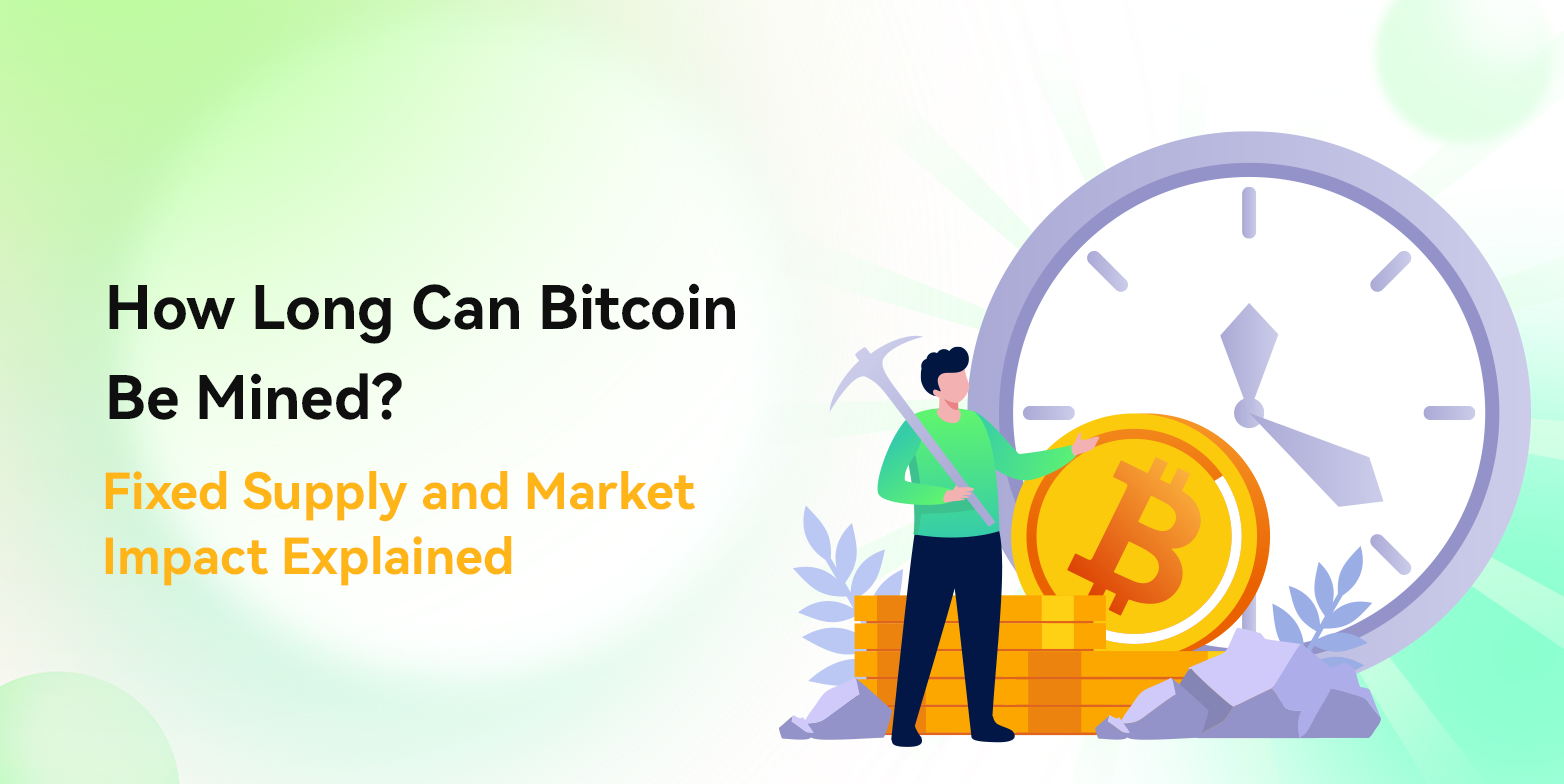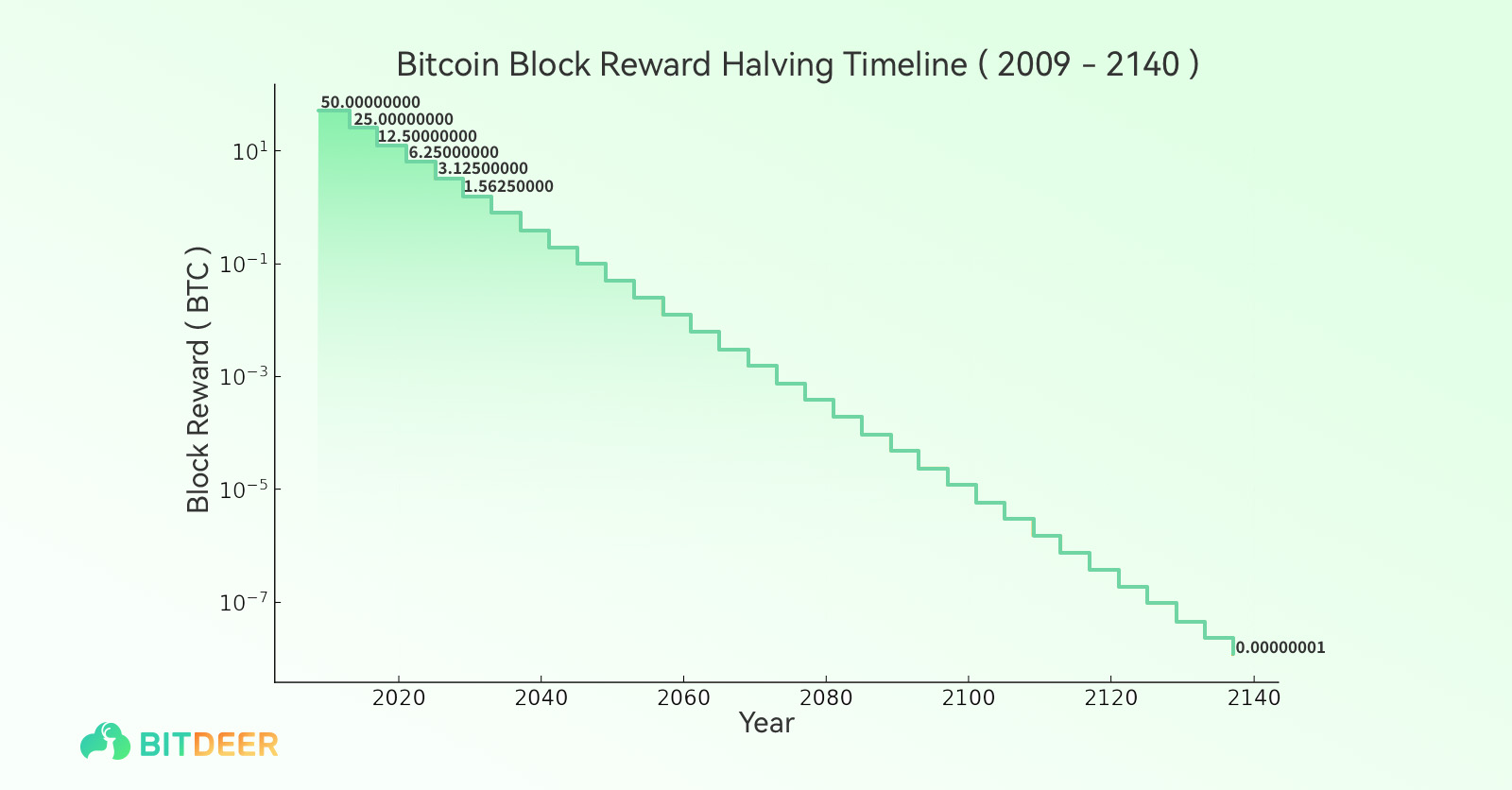
How Long Can Bitcoin Be Mined? Fixed Supply and Market Impact Explained
23 September 2025
In this article, we’ll unpack Bitcoin’s fixed supply design, revisit each halving event in history, and explain what all this means for both everyday users and the broader market—now and in the future.
Most of the Bitcoin that will ever exist has already been mined, with only a small portion left to enter circulation. That naturally leads to a big question: how much longer can Bitcoin be mined? And when will the very last coin come into existence? In this article, we’ll unpack Bitcoin’s fixed supply design, revisit each halving event in history, and explain what all this means for both everyday users and the broader market—now and in the future.
Why Do People Keep Asking “How Much Longer Can Bitcoin Be Mined?”
Whenever people first learn about Bitcoin, this question almost always comes up. How long can it still be mined? And how many coins are already in circulation? The answer starts with its hard cap. From the beginning, Bitcoin’s code set a maximum supply of 21 million. According to CoinMarketCap, by September 2025 more than 19.9 million coins had been mined, leaving about 1 million still to go. In other words, roughly 95% of Bitcoin is already mined.
That might sound like we’re close to the finish line. But not quite. Because of Bitcoin’s halving cycle, the final coin won’t be mined until around the year 2140—over a hundred years from today. That long horizon is exactly why people keep asking: how much longer can this process really last?
Where Did Bitcoin’s Fixed Supply Come From?
The idea goes back to Satoshi Nakamoto’s original white paper. He emphasized that Bitcoin had to be a currency with a predictable supply. Unlike traditional money, which central banks can print endlessly with a keystroke, Bitcoin’s supply is locked in code and can’t be changed.
This design was meant to mimic gold. Gold can’t be created out of thin air, and its supply is naturally limited by how fast it can be mined. That scarcity is what makes gold valuable. Bitcoin was built to copy that scarcity in digital form. It’s why people often call it “digital gold.”
How Does Mining Revenue Change Over Time?
Miners keep the Bitcoin network running by contributing computing power and electricity, and in return they earn rewards. Those rewards come in two forms: block rewards and transaction fees. Block rewards are newly issued Bitcoins, which historically made up most of a miner’s income. Transaction fees are paid by users when they move coins from one wallet to another.
Here’s the key: every 210,000 blocks, the block reward is cut in half. Since a new block appears about every ten minutes, this halving happens roughly once every four years. That means the number of new coins miners receive keeps shrinking over time.
Bitcoin’s Halving Story Through the Years
Back in 2009, when Bitcoin first launched, miners earned 50 coins per block. Hardly anyone realized this strange digital asset might one day change finance. Most miners were hobbyists or programmers running the software on home computers. The coins were worth almost nothing, and curiosity was the main motivation.
In 2012, the first halving cut rewards from 50 to 25 coins. That’s when Bitcoin started catching wider attention. The price jumped from a few dollars to over $100. For the first time, people saw scarcity at work, and Bitcoin moved beyond tech circles into the broader investment world.
By 2016, the second halving dropped rewards to 12.5 coins. By then, global exchanges were making it easier to trade Bitcoin, and public awareness was growing fast. After this halving, the market entered a powerful bull run. Within just over a year, the price climbed from a few hundred dollars to nearly $20,000. Many people first heard of Bitcoin during this cycle.
The third halving came in 2020, reducing rewards to 6.25 coins. That year, the COVID-19 pandemic prompted massive money-printing by governments. Investors worried about inflation, and Bitcoin’s halving made its scarcity even more appealing. The price surged from around $9,000 to an all-time high of $69,000.
In 2024, Bitcoin went through its fourth halving, cutting rewards to 3.125 coins. It’s still fresh in memory, but the market already reacted. Around the halving, Bitcoin once again crossed $70,000, and bullish sentiment picked up steam. Attention quickly shifted to the next big question: what will happen in 2028?
Looking forward, the fifth halving in 2028 will reduce rewards to 1.5625 coins. Issuance will slow even further, and Bitcoin’s scarcity will become even more pronounced. That could be another major turning point in its history.

When Does Mining Actually End?
If the code runs as designed, Bitcoin will be fully mined around the year 2140. But if most coins are already out there, why does it take more than a century to finish? The answer lies in the math of halving.
Each halving cuts rewards in half, from 50 to 25, to 12.5, and now to just over 3 coins. The process continues, with rewards shrinking toward zero. It’s like dividing 1 by 2 over and over: the number gets closer to zero but never quite reaches it.
Bitcoin works the same way. Even though only about a million coins remain, the gradual decline stretches the process far into the future. Think of it like dividing 1 by 3—the decimals go on and on. Bitcoin’s rewards taper off in smaller and smaller fractions.
However, Bitcoin’s system has a strict limit on decimal places, allowing it to be divided only up to eight digits after the decimal. That means the process won’t literally go on forever. Around 2136, the block reward will shrink to just one satoshi—the smallest possible unit—and by about 2140, it will effectively end. At that point, no new Bitcoins will be issued in blocks, and miners’ income will come entirely from transaction fees paid by users.
What Happens After the Last Bitcoin Is Mined?
The network won’t shut down. Blocks will continue to be added, and transactions will still be processed. The only change is that miners will be paid entirely through fees. Today, some worry whether fees will be enough to keep miners incentivized. But as long as people continue to use Bitcoin, the network will keep going. Its value doesn’t depend on creating new coins, but on scarcity and its role as a decentralized global money.
Should Regular Users Be Concerned?
Short-Term Effects
In the near term, users don’t need to worry about Bitcoin running out. The network is stable, and halvings don’t break it. What users do notice is market volatility. In both 2016 and 2020, halvings kicked off massive bull runs, sending prices up several times over.
Transaction fees can also spike after halvings. As block rewards shrink, miners depend more on fees. During busy times, like when a bull market attracts waves of new buyers, fees can rise sharply. For users, this shows up as “why is it suddenly so expensive to send Bitcoin?”
Mining also reshuffles after halvings. Older, less efficient machines with high electricity costs may shut down. That can cause the network’s hash rate to dip temporarily, but it usually bounces back quickly. For everyday users, these shifts aren’t obvious, except through price and fee changes.
Long-Term Effects
Over time, Bitcoin’s scarcity only gets stronger. Fewer new coins are issued, while demand keeps building. In recent years, major institutions have stepped in.
Take MicroStrategy, for example. Since 2020, it has steadily bought Bitcoin, treating it as a core part of its balance sheet. Today, it holds over 590,000 BTC, making it the largest corporate holder worldwide. Another case is Tesla, which once bought Bitcoin as part of its treasury, it still holds over 110,000 BTC. Even though it later sold some, the move showed that serious companies were considering Bitcoin.
A bigger milestone came in 2024, when the U.S. approved spot Bitcoin ETFs. This gave regular investors a simple way to buy in, while the funds themselves had to purchase and hold actual Bitcoin. Billions of dollars flowed in within months, effectively locking away large amounts of supply.
Institutions tend to buy in bulk and hold for the long term. They don’t sell just because of short-term swings. That means less Bitcoin is available on the market, making it even scarcer. For regular investors, this could mean the entry price keeps climbing over time. Just like central banks hoarding gold pushed its price higher, institutional adoption could steadily drive Bitcoin’s value upward.
Learn More with Bitdeer
Want to dig deeper into Bitcoin mining and the stories behind it? Check out the Bitdeer Learning Hub. You’ll find clearer and practical insights to help you navigate the complex world of blockchain.
*Information provided in this article is for general information and reference only and does not constitute nor is intended to be construed as any advertisement, professional advice, offer, solicitation, or recommendation to deal in any product. No guarantee, representation, warranty or undertaking, express or implied, is made as to the fairness, accuracy, timeliness, completeness or correctness of any information, or the future returns, performance or outcome of any product. Bitdeer expressly excludes any and all liability (to the extent permitted by applicable law) in respect of the information provided in this article, and in no event shall Bitdeer be liable to any person for any losses incurred or damages suffered as a result of any reliance on any information in this article.
© 2025 Bitdeer. All rights reserved